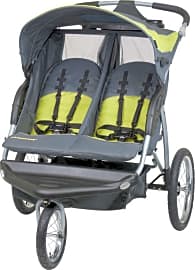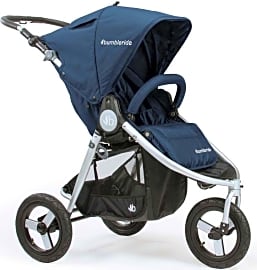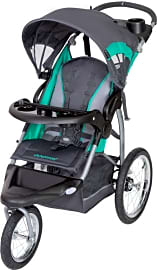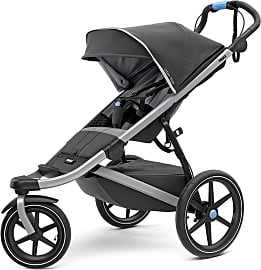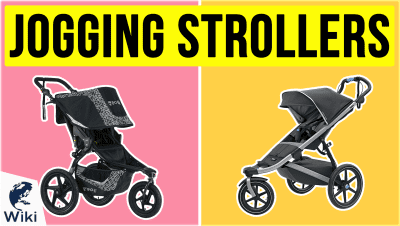The 10 Best All Terrain Strollers

This wiki has been updated 38 times since it was first published in June of 2015. Whether you want to take a little one along on your next hiking expedition or you live in a city with dreadfully uneven sidewalks, one of these trail strollers will make days out with a baby easier and safer, as they deliver a smooth ride over all sorts of terrains. Note that these aren't meant for newborns, so you should always check any model for the manufacturer's recommended minimum age. When users buy our independently chosen editorial selections, we may earn commissions to help fund the Wiki.
Editor's Notes
April 24, 2019:
A stroller gives busy parents a way to safely transport their cutie from point A to point B, but it can (and should) do so much more, considering all that new parents have on their hands. We selected models with features that will make expeditions with the little one more enjoyable for the adult user and child rider. The Delta Children Jeep Sport and the Baby Jogger Summit X3 boast extra-large canopies with sun visors to provide protection from UV rays on hot summer days. Speaking of the heat, the Baby Trend Expedition and the Baby Trend Expedition Double Jogger have mesh backs to provide some nice airflow. If you need to keep a curious kid occupied during longer outings, you'll appreciate that the Costzon Baby Jogger has a removable snack tray and the Joovy Zoom 360 has pouches on the insides of the seat where the rider can store beloved toys or sippy cups. Parents probably want to keep important items nearby, too, which is why the Graco Fastaction, with its smartphone cradle, the Delta Children Jeep Sport, with its large attached storage pouch over the handlebar, and the Joovy Zoom 360, with a zippered pocket by the handlebar for valuables, are very helpful models.
Baby On Board
What's more, all terrain strollers do away with one of the original stroller design's four wheels.
Having a baby is supposed to be an adventure. As parents, we embark on massive unknowable journeys together into what could, at times, be considered madness. All along that journey, and certainly at the other end of it, is a wealth of reward. Any good journey, though, can be augmented by a little daring.
Imagine you and your tot take a nice stroll in the park. The little guy is utterly enamored by the pigeons, but you don't have any bread or scraps on you to throw their way and attract them. If you had an all terrain stroller, you could divert from the safe concrete paths laid out by the park's designers, and take the young man barreling into a landed flock of the birds.
His eyes would light up, big as saucers, while you weaved through the flock, sending a sea of birds skyward. If all you had was a dinky little safety stroller, you'd have to get your boy a pair of binoculars and start saving up for his psychoanalysis.
What makes these all terrain strollers superior to their standard counterparts is all in the design of the wheels. Not only are the wheels larger, but their tires are fatter and sometimes air-filled, providing better traction in less curated environments. What's more, all terrain strollers do away with one of the original stroller design's four wheels.
This might seem like a problem at first. After all, don't cars have four wheels for a reason? They do, but that reason has more to do with steering and advanced traction solutions for the movement of a much larger, heavier vehicle. As it turns out, a triangle is the stablest structure, so having three wheels on your stroller actually creates a design less susceptible to toppling.
The last thing that separates a good all terrain stroller from the rest of the pack is its suspension system. A car's suspension system integrates into the wheels and axles, providing a smoother ride by concentrating the vibrations of an uneven road in the wheel bases. It's the vehicular equivalent of rolling your feet while you walk. These all terrain strollers work on a similar principal, but they use a direct suspension, by which means the basket seat itself is suspended within the frame.
Strolling In Style
For some reason, none of the major networks seem keen on returning my calls about a reality series centered around babies who joust in all terrain strollers. I'd call it 'Tilting Tots.' In medieval times, knights at the tilts would decorate their horses and armor–their shields and lances in particular–either in the colors and sigils of the houses they served, or with an original color and design scheme.
If you go on hikes along rough, rocky trails, more ground clearance will keep your stored goods safe below your baby.
These designs were immensely personal, and, if Game of Thrones is any indication, they make for incredible merchandising opportunities. Just imagine one of these all terrain strollers decked out in the colors and symbols of each baby's house streaking along in the mud as they're pushed forward by bloodthirsty parents.
Maybe it isn't such a hot idea, but it serves to highlight one vital aspect of these all terrain strollers that is likely to reach the top–or at least close to the top–of any parent's stroller criteria: style.
You can evaluate these strollers based on their wheel size and distribution, on their storage capacity or ground clearance, and a dozen other nuanced variables that will add up to affect your strolling experience, but, at the end of the day, the way it looks is going to hold major sway over your decision.
If you can manage to withstand the temptation to make your selection on those looks alone, you ought to ask yourself what kind of all terrain roaming you intend to do. If you're out and about for hours at a time, that storage capacity should move up the list of criteria. If you go on hikes along rough, rocky trails, more ground clearance will keep your stored goods safe below your baby. I'd recommend getting a handle on a few of these variables, then returning to the strollers that remain and considering their appearance.
A Truck For Charlie
For the majority of human history, people either carried their children or made them walk. Perhaps that latter group had a line on some serious insight. I don't recall hearing much about childhood obesity in antiquated civilizations. Then again, they had their own problems.
It wasn't until the early 1700s, when a landscape architect for the Duke of Devonshire constructed a miniature carriage to cart around the Duke's kids.
It wasn't until the early 1700s, when a landscape architect for the Duke of Devonshire constructed a miniature carriage to cart around the Duke's kids. The carriage was pulled by dogs, goats, miniature horses, or just about anything that fit the small harness he'd made. It's enough to make today's overprotective parents recoil in horror.
On through the 19th century, baby carriages remained the property of only wealthy citizens. These carriages faced backwards compared to today's models, as their riders were turned around to face their parents and not the world in front of them. It's not entirely clear why the design switched around, but I'd venture a guess that kids would experience more motion sickness from moving backward and not being able to visually justify the experience of their equilibrium.
Whatever the cause for the switch, the new style stuck, and throughout the 20th century, as plastic and metal materials got cheaper and cheaper, strollers became available to the masses, with these all terrain styles entering the market at roughly the same time that SUVs became popular for adults' strolling purposes.




